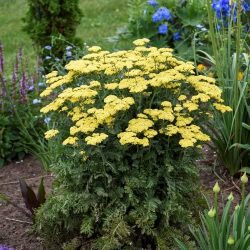Aphids are notorious landscape pests. If you’re familiar with them, you likely already know how hard they can be to manage and how harmful they can be to your plants and property. So, what are the telltale signs that you have aphids in your garden? And, more importantly, how can you get rid of them?

What is an Aphid?
Species of aphids differ physiologically, but adults commonly have green, brown, or red bodies and long, slender mouthparts that they use to suck fluids and sap out of plants. Most species are wingless, and most species have two tubelike “cornicles” protruding from their rear, which is a good way to distinguish them from other insects.

Aphids reproduce asexually; a female can produce up to a dozen “nymphs” in a day without a mate. After birth, many species become reproducing adults within 7-8 days, meaning aphid populations can explode in a matter of days.
And that’s the problem: small populations are largely harmless, but if large populations find their way into your landscape, that’s when problems start.

Source: Aphid responses to drought: a combined physiological and transcriptomic approach
Why are aphids bad?
The short answer? They feed on your plants.
The long answer, of course, is a little more complicated. Aphids actually feed on fluids and phloem saps in leaves, twigs, and stems, which can take important nutrients from your plants and cause metabolic imbalances. From there, the problems only grow:
- If the population is large enough, aphids can cause leaves to turn yellow and fall off
- When aphids feed, they can transmit diseases from plant to plant.
- When they eat, they produce a sugary secretion called honeydew, which is a brownish, sticky substance on leaves. Honeydew attracts other pests, such as flies, ants, and wasps.
- That sticky honeydew substance will also drip all over the surrounding property, causing damage to patio furniture, cars, and hardscapes.
How can I tell if aphids are in my garden?
Large populations of aphids are usually plainly visible to the naked eye. However, it’s important to check regularly for smaller populations on the undersides of leaves so you can remove them before they reproduce. Here are a few signs to look for:
-
Aphid honeydew
Aphid excretion looks like a yellowish-brown sticky substance which forms on leaves, stems, and at the bases of plants.

Aphid honeydew
-
Black, sooty mold
Left uncleaned, honeydew begins to grow moldy, causing damage and decay to your plants.

Black, sooty mold left as a result of aphid infestation.
-
Ants on your plants
Ants eat honeydew, and will “tend” to aphids, treating them almost like pets and defending them from predators. An increase in ant populations on your plants could be an indicator that aphids are also present.
-
Aphid eggs
Aphid eggs are a sure sign of an impending population boom. Check the stems of your plants and the undersides of leaves.
-
White skin casts
Aphids moult, so keep an eye for their discarded skins on leaves.
How do I control Aphids in my garden?
Here are a few tips for managing aphid populations:
Step 1: Physical Controls
- Inspect plants before purchasing
- Prune out colonies
- Spray dormant oils
- Use water to spray aphids off of the undersides of leaves
- Avoid high-nitrogen fertilizers


Step 2: Natural Controls
- Install pollinator plants and flowering plants! Some great choices would be alyssum and yarrow which can attract animals that feed on aphids (ladybugs, lacewing flies, and some wasps), which is an excellent natural way to keep populations in check.


Step 3: Chemical Controls
There are chemical options available, but before using chemicals, it’s important to check your local bylaws to make sure what you’re spraying is legal and safe. Take all necessary precautions before applying any chemical treatments, and make sure you’ve exhausted all other options beforehand! With a little diligence, it’s easy to use physical and natural controls to keep aphid populations at bay.
Can We Help?
Our Plant Health Care division team are pest management experts with years of experience managing aphids. Give us a call for a consulation!





Comments are closed here.